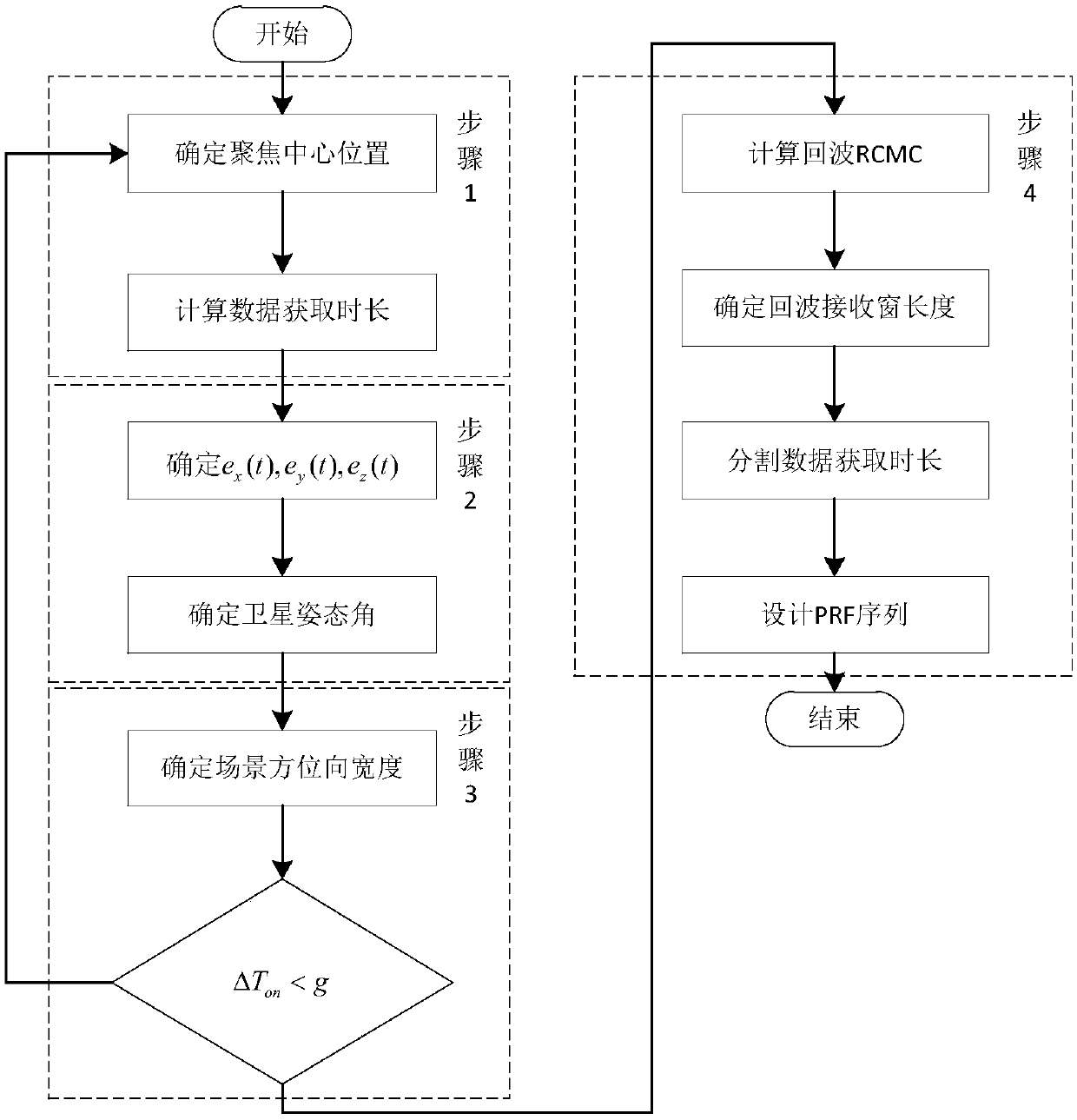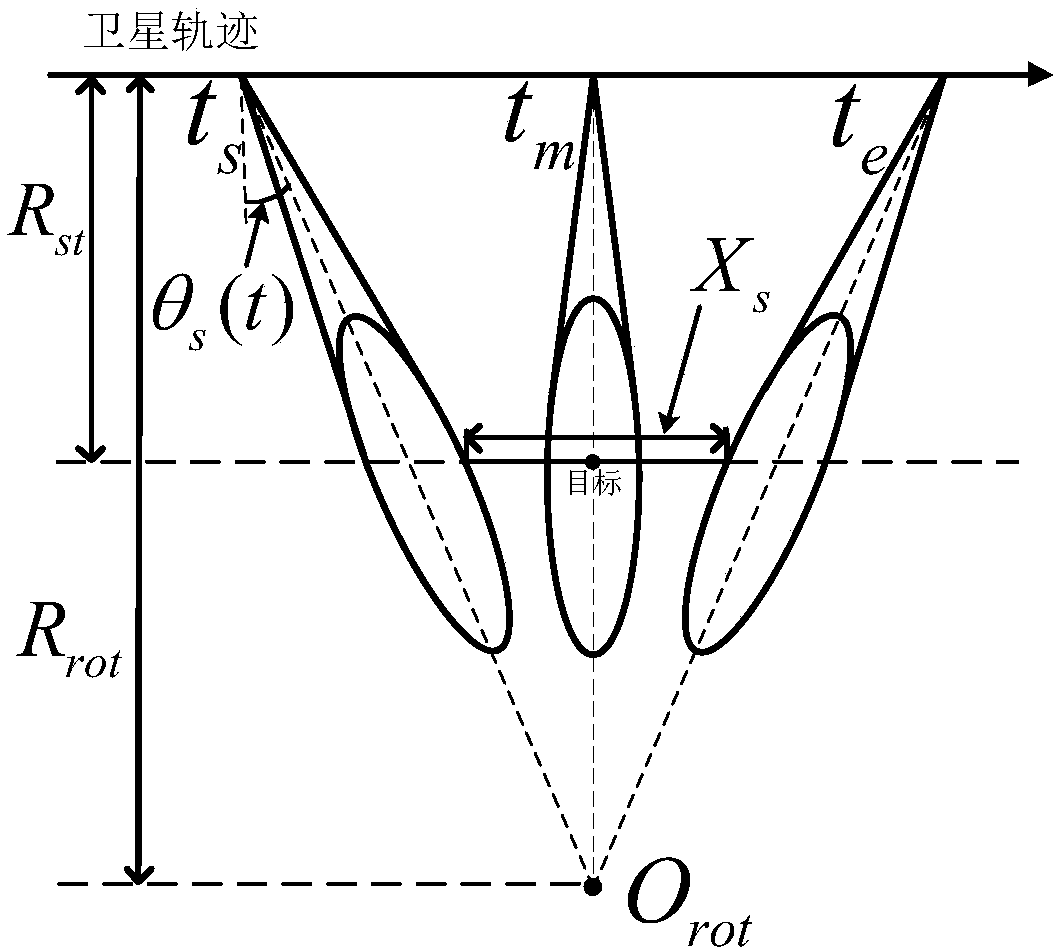Spaceborne sliding spotlight SAR (Synthetic Aperture Radar) satellite attitude and PRF (Pulse Repetition Frequency) sequence design method
A satellite attitude and sliding beamforming technology, applied in the direction of radio wave reflection/re-radiation, use of re-radiation, measurement devices, etc., can solve the problem of small azimuth resolution, lack of roll angle control, and azimuth resolution and other problems, to achieve the effect of reducing the azimuth resolution space, reducing the Doppler bandwidth and Doppler bandwidth bandwidth
- Summary
- Abstract
- Description
- Claims
- Application Information
AI Technical Summary
Problems solved by technology
Method used
Image
Examples
Embodiment 1
[0031] Synthetic aperture radar has the characteristics of all-day and all-weather, and plays an important role in military and civil fields. Due to the unique advantages of high resolution, spaceborne sliding spotlight SAR has become a research hotspot in the field of SAR at home and abroad. For space-borne sliding spotlight SAR, the existing single-axis or dual-axis attitude control will cause the problem of scene curvature; the single data acquisition usually takes more than tens of seconds, the distance migration is serious, and some echoes will fall in the "blind zone" within, so that part of the echo is lost. The present invention has launched research on the above-mentioned problems, and proposes a space-borne sliding spotlight SAR satellite attitude maneuver strategy and a PRF sequence design method, see figure 1 , the present invention performs three-axis attitude maneuvering control, and there is no problem that the irradiation scene is curved and the azimuth resolu...
Embodiment 2
[0038] The attitude maneuver strategy and PRF sequence design method of the spaceborne sliding spotlight SAR satellite are the same as in Example 1, and the initial data acquisition time T described in step 1 is calculated. on method, its sub-steps are:
[0039] 1a) Determine the slip factor α
[0040] The sliding beamforming geometric model such as figure 2 As shown in , it is assumed that the working mode of the spaceborne sliding spotlight SAR is right-looking, and the satellite moves from left to right along the trajectory, t s is the start time of data acquisition, t m Get intermediate instants for the data, t e It is the end time of data acquisition. θ s (t) indicates that the satellite is at t s Beam center oblique angle at time, R rot means t m The slant distance from the moment focus center to the satellite, R st means t m The slant distance from the center of the scene to the satellite at any moment, X s Indicates the effective width of the azimuth direct...
Embodiment 3
[0057] The spaceborne sliding spotlight SAR satellite attitude maneuver strategy and the PRF sequence design method are the same as those in Embodiment 1-2, the method for determining the satellite attitude angle described in step 2, and its sub-steps are:
[0058] 2a) Determine the direction of the coordinate axes of the satellite body coordinate system under the ground-fixed system. The satellite body coordinate system is a Cartesian rectangular coordinate system, and the coordinate axes conform to the right-hand rule. image 3 Obtain geometric schematics for squint radar data, where R S is the current position vector of the satellite, V S is the satellite velocity vector, T n is the position vector of the near end point of the beam coverage area at the current moment, T f is the position vector of the far end of the beam coverage area at the current moment, X B , Y B and Z B are the three coordinate axes of the satellite body coordinate system.
[0059] 2a.1) Find the...
PUM
 Login to View More
Login to View More Abstract
Description
Claims
Application Information
 Login to View More
Login to View More - R&D
- Intellectual Property
- Life Sciences
- Materials
- Tech Scout
- Unparalleled Data Quality
- Higher Quality Content
- 60% Fewer Hallucinations
Browse by: Latest US Patents, China's latest patents, Technical Efficacy Thesaurus, Application Domain, Technology Topic, Popular Technical Reports.
© 2025 PatSnap. All rights reserved.Legal|Privacy policy|Modern Slavery Act Transparency Statement|Sitemap|About US| Contact US: help@patsnap.com



